Honestly, when I returned the 140 horsepower diesel Cherokee I didn't cry. I didn't look back. It is not a car that caused me a special feeling or left me a pleasant memory to miss it. Comfortable and comfortable to drive quietly on the road, it had good ways to explore the mountain roads and some more complicated areas. I'm not going to repeat the whole test, you can read it here, in fact. Its downside, at Pistonudos level, is that it had no character, and that, when you buy or value cars with your heart, ends up being a problem.
Jeep has always said that one of its new-era priorities is to remain the queen of off-road driving in every segment it enters, at least through a sufficiently competent version. In the case of the Cherokee, the base (solid, rigid, heavy) had the necessary preparation to accommodate the TrailHawk, a bug that, at least for the moment, in Spain is only offered with the 271 horsepower petrol engine, a handicap in itself for any buyer concerned with visits to the gas station (you had to see how the Cepsa guy smiled last week every time he saw me approach).
The question is, is the TrailHawk the Cherokee with character we were looking for? Well yes, I'm not going to make you wait for the end, for the conclusions. There's something weird about this car. It's like a drug. I don't really know why, I don't really understand it, I really don't, but I want one. I want one "desperately" for reasons that my mind can't rationalize.
Design
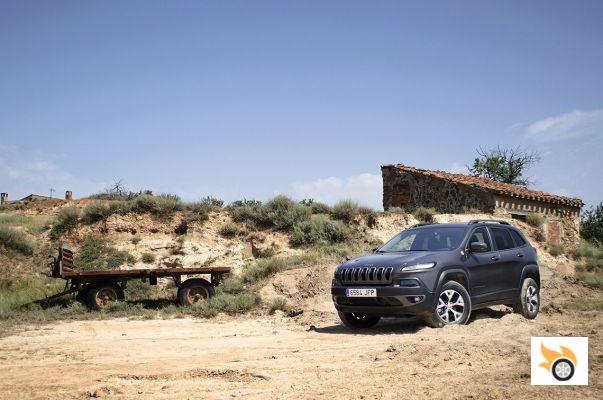
The first thing that strikes you as soon as you see it is that it's more macho, much cooler than the road versions. But why? Well, it all starts with an unpainted plastic front bumper, which surrounds the main projectors, and has a much better angle of attack (29.9 degrees) to prevent you from hitting rocks and slopes.
The chrome disappears and gives way to a rough, textured grey that's cool. The side view is dominated by new plastic wheel arches, larger and larger than those of the normal Cherokee. It may seem silly, because the change is not exaggerated, but they are sufficiently marked to give an extra testosterone to the device.
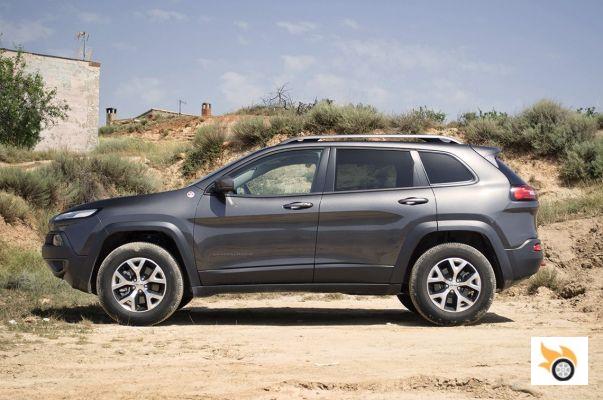
The wheels have tyres with a very generous profile, which makes the full wheel fill the wheel arches much better and the car looks wilder. The extra ground clearance in side view also helps in this front.
At the rear, the bumper is also cut diagonally overhanging, bringing the departure angle to 32.1 degrees, again giving it an advantage in off-road driving. The twin exhaust tailpipes and the exposed muffler round off the macho look.
The dark pearl grey colour with shiny particles, which seems to flow through the bodywork and the fact that the logos are also in matt grey, instead of chrome, like the mirrors, finish off a car that is "cool to look at", like its red towing ring at the rear.
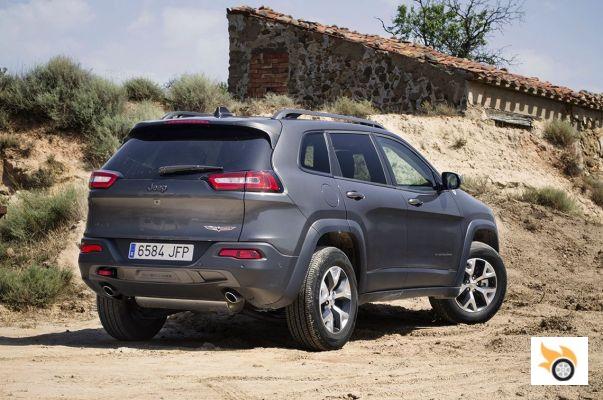
So yeah. I, one of those who disowned the new Cherokee when he saw the first snapshots, I dare to say that today, aesthetically speaking, the Cherokee TrailHawk is cool. I'm cool enough to want one.
Cabin
This is where there's the least differentiation from the "more normal" Cherokee in the lineup. No, no evil hackers hacked into my car via the infotainment system and shook me, although I have to admit I was genuinely terrified after what I'd read the week before and every young man approaching with a smartphone in his hand posed a threat to me... No, seriously now, the TrailHawk pulls the 8.4-inch UConnect system as the star of the dashboard. It's standard here, and has the same benefits and drawbacks as in the regular Cherokee.
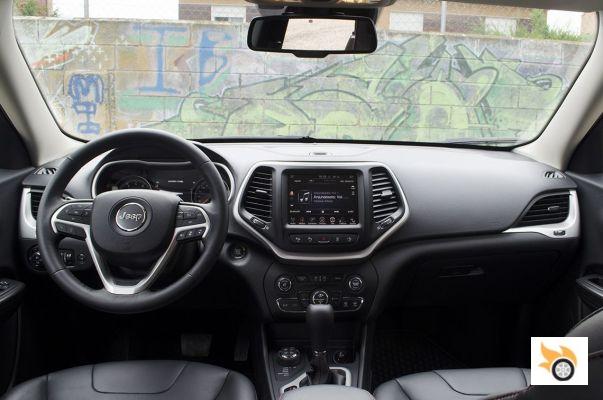
There are some more specific new features. The instrument cluster gets a high-resolution color LCD screen that's larger than the 140 hp's monochrome one, and with more information to display (it's welcome).
The rotary knob that accompanies the gear lever has more operating modes than in the "normal" Cherokee with Active Drive I, in addition to having buttons to choose the reduction gear, the rear differential lock and also the active speed control for descents or to roll slowly in difficult areas.
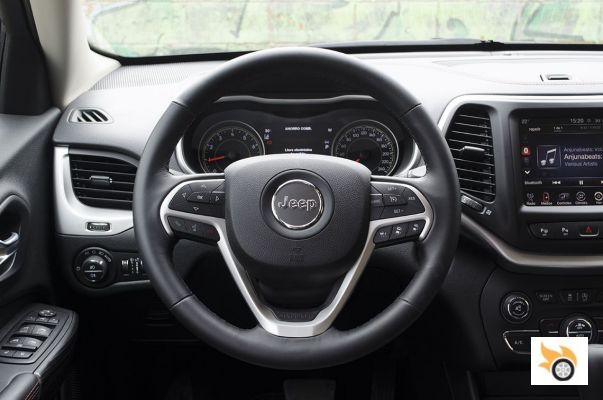
The designer who was commissioned to make the gear lever must have been given a working day to do it, because it is a piece without any history, bland and bland, in the purest Yankee style.
The seats receive an embroidery where you can read "TrailHawk" (the upholstery is standard leather), and as happened in the diesel, here there is plenty of room in the front seats, and the rear are more than worthy.
Under the boot floor there's a spare wheel which, while not the traditional "cookie cutter", isn't the same size as the rest of the car's wheels, because it simply won't fit in the boot. It's nice, in any case, that an off-roader has a "decent" sized spare wheel so that you can roll it back if you blow the standard rubber by doing a stunt more like an Ari Vatanen than a responsible family man.
By the way, the car's floor mats are wisely made of rubber. So when you get mud on your boots, it won't hurt so much to get in the car.
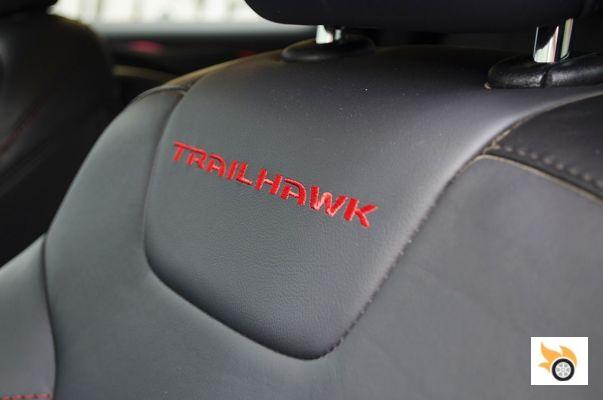
The boot lid is robotised, which is great for those of us who don't break sizes so we can close the boot lid without jumping out or standing on tiptoe in the shopping centre car park while the 18 year olds laugh at your 1.73 (yes, this is a true story...).
Technical
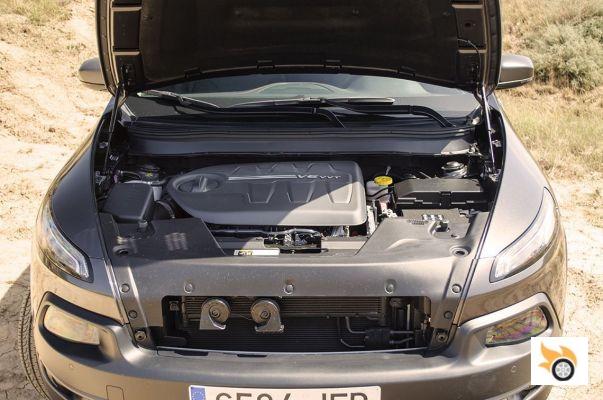
When we tested the 140 hp diesel I told you that it was a heavy car (almost two tons), among other things because a monocoque had been designed from the beginning to be an off-roader with great capabilities. That extra weight that drag all Cherokee makes logical sense in this version.
Under its front hood is the naturally aspirated 3.2-liter Pentastar V6 with 271 horsepower and 316 Nm of peak torque at 4,400 rpm. It is positioned transversely just in front of the front axle, practically placed on top of it, taking advantage of the available headroom.
With an aluminium cylinder head and block, this engine of Chrysler origin, plays the trump card of lightness, especially for the traditional Yankee standard, with technology in the cylinder head in the form of double camshaft per bank and four valves per cylinder.
It is associated with the new nine-ratio automatic gearbox ZF automatic gearbox that both pride, but also headaches, a given to FCA. It is accompanied in its mission by a gearbox to facilitate the off-road capabilities of the Cherokee. The center differential has electronic control to distribute the torque according to the demands. Thus, the electronic control module can make TrailHawk a front- or all-wheel-drive car. In addition, the rear differential can be locked to ensure you get out of the trickiest situations.
The front suspension is a McPherson strut system, while the rear suspension is a multi-link system with independent wheels.
On the road
Just by looking at the TrailHawk's specs on the spec sheet, you know it's not going to be the best cornering road performer. Surprisingly, it's just as good around town as the conventional diesel versions. In fact, the slightly higher ride height, better angles of attack and more tyre profile available make passing bumps, speed bumps, potholes and kerbs even more enjoyable.
Of course, with 14 litres per 100km of fuel consumption, which is where you can get around town, you might be a little scared. But the automatic gearbox combines perfectly with the Start&Stop system to create a very smooth urban driving experience when leaving traffic lights and entering roundabouts.
If you leave the city for a long road trip, you'll be positively surprised by the comfort. It still isolates from noise as well as the diesel, plus the aluminium petrol V6 sounds much better than its range mate.
Potholes are swallowed with finesse, and putting miles behind the wheel is comfortable if you're driving leisurely on a motorway or dual carriageway. Even if you're driving on an open country road without many bends you'll be marked positively, especially when it comes to overtaking, because with an 80-120 in six seconds, as we have timed, you can overtake trucks faster than with many sedans (read Passat with 150 hp, for example).
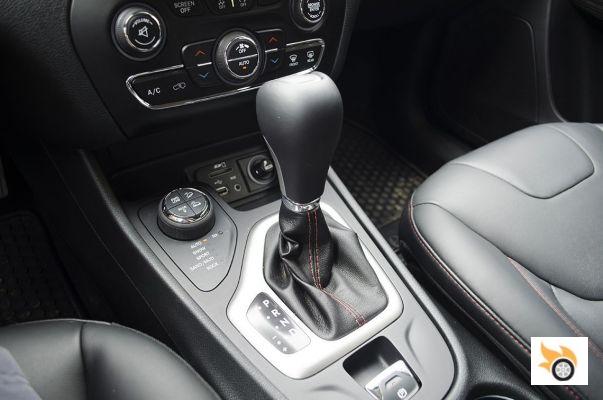
The drawbacks on these types of roads already give you a hint of what will happen when you reach the curves: as a good "all-terrain" Jeep, it lacks brakes. For starters, the pedal feel is bad, spongy. You have to step on it a lot to start braking. As it is a tall car and has a soft suspension, it pitches markedly, and the stopping distances are long. The use of tyres well suited to track driving means that Jeep has preferred to play with brakes of this type rather than more powerful ones that could put the tyres in trouble.
Here the 140 hp diesel we tested three weeks ago braked much, much better. Closing the chapter of the quiet road trip, I will tell you that the air conditioning is powerful, and the audio system is impressive. The fuel consumption in these circumstances can go down to nine litres per 100 kilometres. It's not low but it's less than what you can drink in the city.
The use of the active lane following assistant and the adaptive cruise control will convince you that you can put some serious mileage on it.
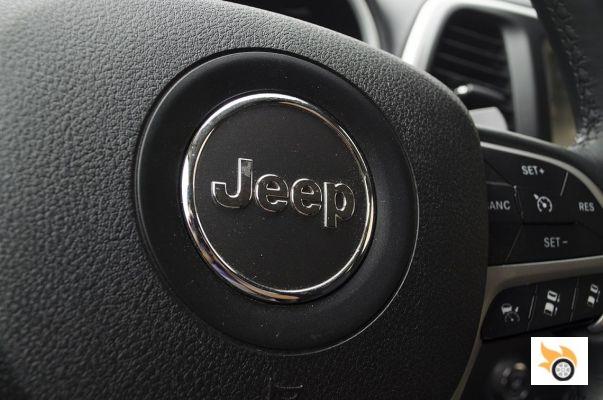
And then it's time for the bends. We all knew from the start, you and I, that this wasn't its thing. The thing is that the V6 sounds so good, and pushes so hard, that you end up pushing it. By selecting "Sport" mode on the rotary knob next to the gear lever, the gearbox tries to keep the engine in its good zone for as long as possible. Manual use of the nine-speed gearbox is not very intuitive, because the lever is not easy to reach and there are no paddle shifters behind the steering wheel. It's better to trust the box in automatic mode, although it has considerable mental lapses at times and you don't know whether to downshift or not when you press hard on the right pedal.
Accelerating, as I said, it accelerates surprisingly well for a two-tonne car. But once launched, you have to stop them, and the brakes are a little too big for that. You have to think about that constantly. The nose dips under braking, and the car leans quite a bit under cornering, which, coupled with the fact that it uses wide "Yankee ass size" seats, makes you wiggle around in them.
The steering is totally inert. The car goes where you tell it to go, but it doesn't talk to you. It's an act of faith on that front. The curious and surprisingly good thing is that despite the generous body movements, it doesn't wobble. The damping is very well matched with the springs and only the bounce due to the large profile of the tyres makes the precision of the line less than perfect.
Noble it is. Fun, too. You laugh. At least I did, going with such a bug, accelerating as it accelerates, and braking. You can't go fast in a corner, but it gives you a comical and pleasurable sensation, plus a complete sense of security, that it won't bite you if things get out of hand, which I didn't try to provoke either, given the weight involved.
Driving like this you can laugh reading the instantaneous fuel consumption figures. At one point I saw it read 75 litres per 100 kilometres. The average of 16 seemed to me to be even lower...
In the bush
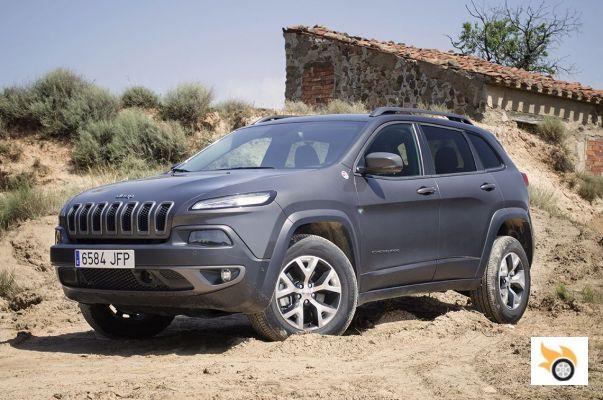
But this car is made and designed to go off-road. And as soon as you leave the asphalt you notice that it is comfortable there. Solid as a rock, it swallows potholes and bumps in comfort. The ultra-filtered steering here prevents you from having to massage the palms of your hands intensively, which is always welcome.
Thanks to the tyres fitted for the occasion, there's more grip than in the 140bhp diesel when braking and cornering.
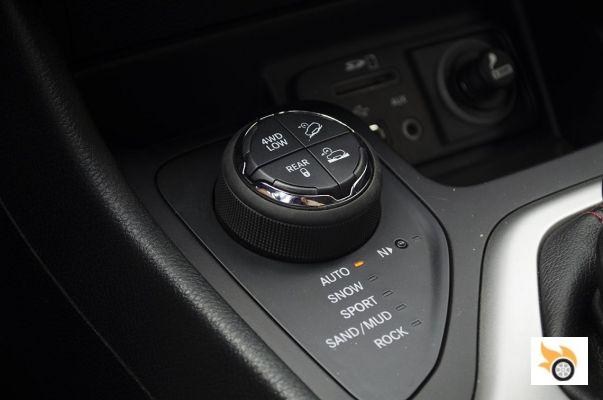
If you decide to start making life more complicated, you just need to get off the track and start using the magic wheel to choose whether to drive on snow, rock or mud, and whether you need cruise control, lock the rear differential or choose the reduction gear to become 'unstoppable'.
It's all much simpler and smoother than in a traditional off-roader like the Wrangler. I will tell you that it's also a smoother off-road driving experience than you'd get in a current Montero or other off-road capable machines, matching the ease of the much bigger and more expensive Range Rover or Grand Cherokee.
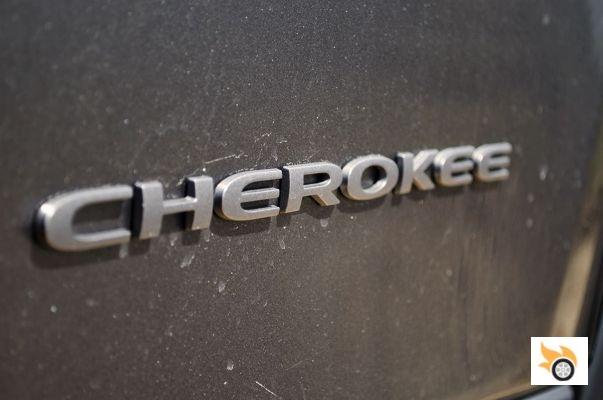
Even a klutz like me can get into a sort of sandpit (the owner of the farm I think he hates me now) and play with the reduction gear and the rear differential lock to plough, ah, no, to get out of a standstill in the middle of an incredible cloud of dust without fear of getting stuck in place.
Climbing a rocky knoll, descending a steep muddy slope... I wasn't able to get the Cherokee TrailHawk into trouble.
Remembering the presentation of the model in Balocco, the FCA test track that has an off-road test area, I could see that this car is able to do real stunts typical of extreme off-road routes, and that I have not encountered in real life in all my journeys. Ok, I'm not the best example of off-road driver to use, but with this device I would dare to climb anywhere, and best of all, is that it gives the feeling that no matter how amateurish or inexperienced in advanced routes you are, the car will always be there to help you.
The only downside is that with such a gas guzzling engine, you can find yourself with a range of 350 kilometers, so it is advisable to fill the tank before leaving the road, lest you get stranded along the way.
Conclusions
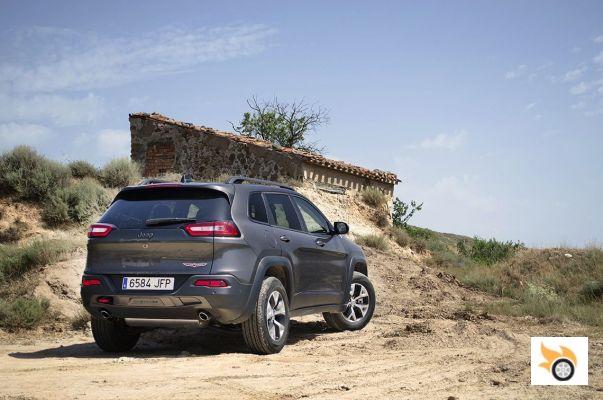
Objectively, it's hard to explain why, but the Cherokee, in TrailHawk trim, is a real charmer. It makes you fall in love where the 140-horsepower diesel failed to create any sensation, and that's because they are identical in many ways, although different in details.
It's those details that make the TrailHawk special, I guess. That feeling in the bush of being able to go wherever you want to go. The freedom and confidence that comes from knowing that you're not going to snag the underbody (which, by the way, is protected by steel plate), and that you'll have plenty of power.
The V6 engine and its exaggerated power on the road create another nexus of complicity between car and user: engine sound and thrust are allied to make you fall in love, even if it uses too much fuel.
With reason I will tell you that it is difficult to recommend it, because it is difficult to find the type of customer. I imagine that if you want a car really capable off-road, but equally useful for everyday life, with which you can travel in comfort, but at the same time dare to reach a wild beach on a very complicated trail, the Cherokee TrailHawk can be your friend. But you've got to want power and engine, and you've got to care, forcibly, about fuel economy.
In that sense, it's the antithesis of the petrol Macan S. Where you'd buy the Macan as a passionate SUV to drive on tarmac and never, or almost never, go out in the mountains, with its 340 horsepower, the TrailHawk is positioned at the opposite pole, as a fun machine with which to have a good time in the bush, which is what an SUV is all about, isn't it?
Its £53,990 price tag is no mean feat, but it doesn't really have a direct rival to compete with. The Montero, as a TT alternative, with five doors and 200 hp is a diesel, and it's nothing like it in terms of road, equipment or interior finish, as well as being much, much longer (4.9 metres to the Cherokee's 4.6). Among the D-segment SUVs, none has the hill-climbing ability of the Cherokee TrailHawk, let alone the power of the Cherokee TrailHawk. Without leaving Mitsubishi, the Outlander (perhaps another fairly direct rival to the "normal" Cherokee), also has no off-road capabilities at the level of the TrailHawk, nor an engine with which to stand up to it for power, besides having become a much more asphalt product.
I can only think of the new Discovery Sport, which with 4.59 meters almost nails the dimensions of the Cherokee. But then again, the more powerful Discovery Sport only has 179 horsepower. The Cherokee has better all-terrain dimensions, is more powerful and costs a similar figure.
Conclusion? Well, it's only on the market. If you fall in love with it, you'll be lost, because you won't have a choice.
In any case, I ask myself, and I ask Jeep by the way (product manager, I know you're reading me) why not release a TrailHawk with the new 2.2 liter diesel engine with 210 horsepower? With that engine would eat the biggest drawback of this TrailHawk (consumption), and although it would not be so passionate engine or sound so good, while retaining the off-road capability, the firm would have the ultimate TT to go off-road.

























